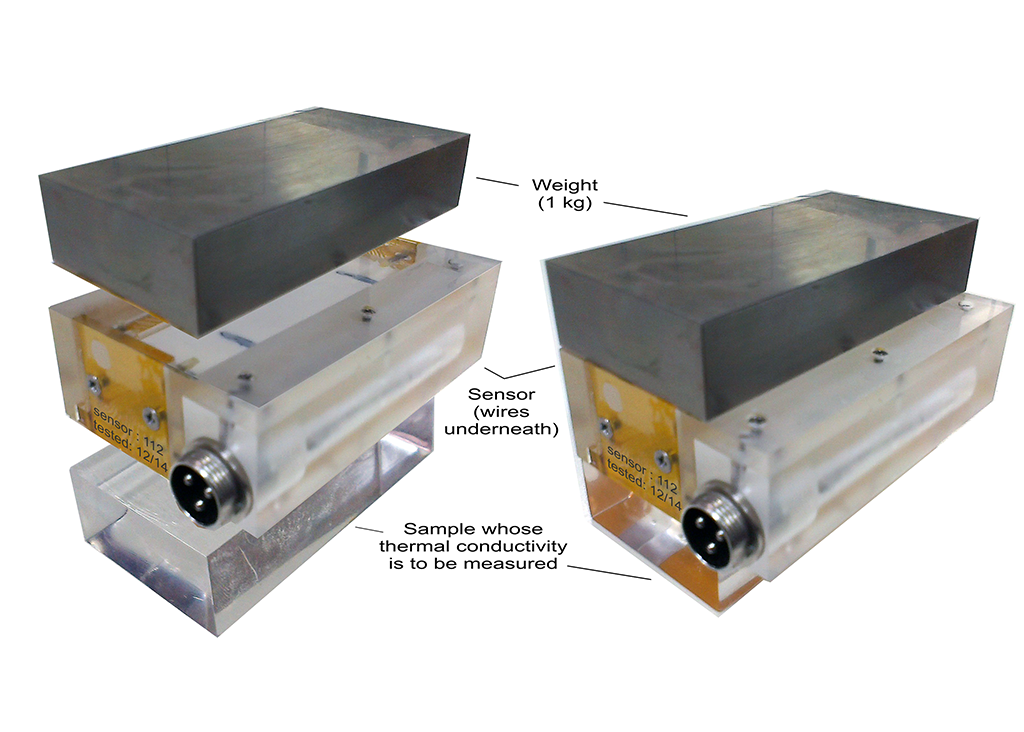| Transient Hot Wire (thw-01S) | Request a Quote |
|
The technique
The Transient Hot-Wire technique has successfully been applied for the measurement of the thermal conductivity of fluids since 1980. According to the transient hot-wire technique, the thermal conductivity of the sample is determined by observing the temporal temperature rise of an embedded thin wire, when a step voltage is applied to it. In this way, electrical current flows through the wire and heats it up, thus creating in the sample a line source of essentially uniform heat flux per unit length that depends on the thermal conductivity of the sample. For absolute measurements, two identical thin wires, differing in length should be employed.
 |
 |
| Sensor with 2 wires in the middle | FEM representation of Sensor and Sample |
The main problem in its application to solids was always the contact resistances. The problem has been eliminated in our new sensor. The sensor is composed of two thin platinum wire (to avoid end effects) embedded in a soft silicone-paste layer, that rests on the one side on a plastic support. On its other side, the solid sample to be examined is placed. A thin polyimide film protects the silicone paste from the solid. Thus heat from the wire, is transmitted through the silicone paste to the solid on the one side and the plastic support on the other side. The thermal conductivity of the sample is obtained by modelling through FEM, the exact geometry of the sensor.
An automatic electronic bridge records 500 resistance rise points in time from 0.001 to 10 s. These are converted to temperature rise vs time. Assuming a value for the thermal conductivity of the sample, the full Fourier equations (in the wire, in the silicon paste and in the support and sample) are solved by FEM, and the resulting temperature rise vs time line is compared with the experimental one. When the two lines coincide, then the correct thermal conductivity value of the sample is found.
The whole process of iteration is accomplished by a novel way employing Machine Learning and the method of Bayesian Optimization.
Instrument
The instrument is composed of :
- A sensor with two-Pt wires of 12 μm diameter embedded in a 1.2-mm thick soft silicone paste that rests on the one side on a plastic support. On its other side, the solid sample to be examined is placed. A thin polyimide film protects the silicone paste from the solid.
- An automatic electronic bridge that employs an ARM architecture CPU to control output voltage and data processing. It has the ability to begin measurements from 1 ms after the initiation of heating and to obtain a large number of data points (usually 500 in one run).
- A laptop that controls the experiment setup. It includes a) the AccuMeasurement custom designed software that performs the measurements, and b) the AccuAnalysis custom designed FEM software for analyzing the results and obtaining the thermal conductivity.
Further reading
The instrument was developed through a Greek-Chinese collaboration. Further information can be obtained in literature:
- Assael M.J., Antoniadis K.D., Metaxa I.N., Mylona S.K., Assael J.-A.M, Wu J., and Hu M., “
A Novel Portable Absolute Transient Hot-Wire Instrument for the Measurement of the Thermal Conductivity of Solids”. Int. J. Thermophys. Online first (2015). - Assael M.J., Antoniadis K.D., Kakosimos K.E., “An Improved Application of the Transient Hot-Wire Technique for the Absolute Accurate Measurement of the Thermal Conductivity of Pyroceram up to 420 K”, Int. J. Thermophys. 29:445-456 (2008).
- Assael M.J., Antoniadis K., and Wu J., “New Measurements of the Thermal Conductivity of PMMA, BK7 and Pyrex 7740 up to 450 K”, Int. J. Thermophys. 29:1257-1266 (2008).



